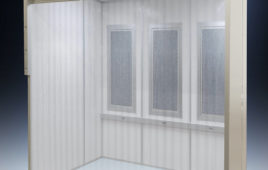A young boy named Hassan has received a new lease on life, thanks to skin transplants developed in a German cleanroom.
Hassan suffers from junctional epidermolysis bullosa, a genetic skin disease he was born with that had devastated about 80 percent of his epidermis. The disease is characterized by a defect in protein-forming genes necessary for skin regeneration. Blisters, wounds, and skin loss and scars result from even the slightest touch, and internal organs and tissue (such as the esophagus and urinary tract, which skin gene therapy cannot repair) can also be affected. There are about 25,000 people in the U.S. with the condition, and half a million around the world.
There is no cure for junctional epidermolysis bullosa. Typically, around 40 percent of sufferers die before they reach adolescence. Those who survive suffer from chronic wounds, and skin cancer is common.
A team led by a Stanford Medicine published a report in JAMA last year, after they tried treating smaller areas of affected skin in adults, but those that saw improvement typically declined within a year. Some researchers have tried bone-marrow transplants to overcome the disease’s genetic flaws, but unfortunately the side effects have resulted in the deaths of several children who underwent the treatment — those that survived have met with mixed results.
Hassan landed in the PICU of Ruhr-Universität Bochum in Germany in 2015 when he was 7 years old, suffering from high fevers and sepsis. His weight dropped to about 37 pounds. Medical experts tried in vain for two months to help him, with one commenting, “We had a lot of problems in the first days keeping this kid alive.” Strong antibiotics were applied, and the boy’s father even donated his own skin for Hassan, but that didn’t work.
Doctors sadly resigned themselves to Hassan’s poor prognosis. They made him as comfortable as they could with morphine and bandages, and awaited his fate.
Hassan’s distraught parents begged doctors to try anything they could think of. So a team from the Ruhr-Universität Bochum’s burn unit and the Center for Regenerative Medicine at the University of Modena proposed an experimental procedure — could they develop skin transplants developed from the boy’s own stem cells, and use it as a transplant on the majority of Hassan’s body? Such a transplant was only performed twice before, and never on such a large portion of the body.
With a certain, painful death looming for little Hassan, everyone decided it was worth a shot.

A stem cell graft is being prepared during surgery. © Frank Jacobsen
The genetically modified stem cells, taken from an unaffected part of Hassan’s body through a skin biopsy, were harvested in a cleanroom laboratory. The cells were taken from only about half a square inch of Hassan’s skin. Researchers then utilized a benign virus to deliver a normal version of the gene into the harvested skin cells, in order to avoid the mutation in the genetically engineered cells — a variant of a gene called LAMB3. They were then made into transgenic transplants.
The operating rooms at the Bergmannsheil needed to be certified as a genetic engineering facility before the transplantation could proceed.
The new skin was applied to Hassan’s limbs in October 2015. It was later applied to his whole back in November. Other transplants, done later in a smaller procedure, covered his flanks and part of his stomach, neck, and face. A total of nine square feet of transgenic epidermis was used to replace nearly 80 percent of his entire body surface. Hassan is the first patient in the world to undergo a procedure to transplant skin made from transgenic epidermal stem cells onto a large part of the body.
After the surgery, Hassan’s condition started to improve. The transgenic stem cells created a new epidermis, showing intact binding proteins in all of the transplanted areas. A major concern regarding inserted genetic material is that dangerous side effects — such as switching off an essential gene, or switching on a gene that could cause cancer — could occur, but doctors could not find the added genetic material in any worrisome places on Hassan.
Hassan was hospitalized in intensive care for about eight months, including over four months in a medically induced coma to spare him pain. He was discharged from Ruhr-Universität Bochum in February 2016.
Today Hassan has smooth skin that doesn’t require ointments or medicine. He still has some blisters in nontransplanted areas, but they only affect about 2 or 3 percent of his whole body surface. His hair is starting to grow, and he has no scar contractures in transplanted areas.
Long-term study of Hassan is necessary to show if the treatment will ultimately be a success, and if the procedure could work for adult patients as well as those suffering from other forms of junctional epidermolysis bullosa.
But, for now, Hassan is able to go to school again and join his family in social activities. He’s even playing soccer.
The case has been reported in the journal Nature.




